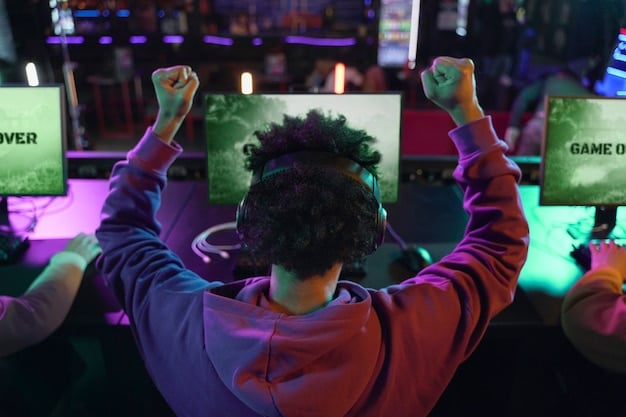Esports Broadcasting Rights: US Deals with Streaming Platforms

Esports broadcasting rights in the US involve negotiating complex deals with streaming platforms like Twitch and YouTube, impacting revenue, audience reach, and the overall value of esports events for organizers and teams.
Navigating the landscape of esports broadcasting rights: negotiating lucrative deals with streaming platforms in the US can be a game-changer for organizations. Understanding the intricacies of these agreements is crucial for maximizing revenue and expanding audience reach.
Understanding Esports Broadcasting Rights in the US
Esports broadcasting rights are the legal permissions that allow streaming platforms to transmit live or recorded esports competitions to viewers. These rights are a critical revenue stream for tournament organizers and esports leagues.
Securing these rights involves negotiating agreements that define the scope, duration, and financial terms of the broadcast.
The Importance of Broadcasting Rights
Broadcasting rights are the backbone of sustainable esports business models. Without them, leagues would struggle to generate revenue and attract sponsors. They dictate who can show the content, how they can show it, and where it can be shown.
These rights underpin the financial viability of professional gaming and the ecosystem that supports it.
- Ensuring revenue generation for tournament organizers.
- Providing exposure for esports teams and players.
- Attracting sponsorships and advertising revenue.
- Maintaining the integrity and exclusivity of the broadcast.
In conclusion, understanding the core elements of esports broadcasting rights is vital. These rights form the bedrock upon which successful esports businesses and leagues thrive, determining the flow of revenues, sponsorships, and overall audience expansion.
Key Players in Esports Broadcasting Deals
Several key players are involved in esports broadcasting deals. Recognizing their roles and motivations is crucial for successful negotiations.
The main entities include tournament organizers, game publishers, streaming platforms, and esports teams.

Tournament Organizers
Tournament organizers are the main entities that hold the rights to broadcast their tournaments. They seek to maximize revenue through broadcasting deals while ensuring broad viewership.
Examples of tournament organizers include ESL, DreamHack, and Major League Gaming (MLG).
Streaming Platforms
Streaming platforms like Twitch, YouTube, and Facebook Gaming compete for exclusive rights to esports content. They provide the infrastructure and audience reach that esports organizations need.
These platforms attract viewers by offering exclusive content and interactive features.
- Twitch: Popular for its live streaming capabilities and established esports community.
- YouTube: Offers vast reach and integration with Google’s advertising network.
- Facebook Gaming: Leverages Facebook’s social network for broader audience engagement.
In summary, the landscape of esports broadcasting deals is shaped by the interaction of diverse key players, each with unique objectives. Recognizing their roles and motivations is vital for successful negotiations and the continued growth of the esports industry.
Negotiating Strategies for Lucrative Deals
Negotiating lucrative deals involves a strategic approach that considers factors like exclusivity, content type, and audience demographics. Organizations need to understand their leverage and the market dynamics.
Effective negotiation strategies can significantly impact the financial outcome of broadcasting agreements.
Exclusivity vs. Non-Exclusivity
Exclusivity can command higher fees but limits reach to a single platform. Non-exclusivity allows for broader distribution but may reduce individual deal values. Weighing these options is essential.
The choice depends on the specific goals of the esports organization.
Content Bundling
Bundling different types of content, such as live matches, highlights, and behind-the-scenes footage, can increase the value of a broadcasting package. It provides more comprehensive content for platforms.
This strategy aims to cater to a wider range of viewer preferences.
- Live Matches: The core offering, drawing in the largest viewership.
- Highlights and Replays: Cater to fans who missed the live action.
- Behind-the-Scenes Content: Offers an intimate look at teams and players.
Effective negotiation strategies in esports broadcasting revolve around striking a balance between exclusivity and reach, leveraging content bundling, and thoroughly understanding audience demographics. A well-structured negotiation can greatly impact the financial outcomes of broadcasting agreements.
Understanding the Legal Aspects of Esports Broadcasting
Esports broadcasting deals are governed by various legal considerations, including copyright, intellectual property, and contract law. Organizations must navigate these complexities to avoid legal pitfalls.
Having legal counsel familiar with esports is highly recommended.
Copyright and IP Protection
Copyright laws protect the intellectual property of game publishers and tournament organizers. Agreements must clearly define the use of copyrighted material to prevent infringement.
Clear guidelines on usage rights are critical.
Contract Law Essentials
Contracts must specify the rights and obligations of each party, including payment terms, broadcast territory, and termination clauses. Ambiguities can lead to disputes.
Well-drafted contracts are essential for protecting interests.

- Defining Rights and Obligations: Clarifying the responsibilities of each party.
- Payment Terms: Specifying payment schedules and methods.
- Termination Clauses: Outlining conditions under which the agreement can be terminated.
In conclusion, navigating legal aspects such as copyright and contract law is vital. By having experienced legal counsel and well-drafted agreements, esports organizations can protect their interests and foster sustainable partnerships with streaming platforms.
Monetization Strategies for Streaming Platforms
Streaming platforms employ diverses monetization strategies to generate revenue from esports content. These strategies impact the financial returns for esports organizations.
Understanding these models can help negotiate better deals.
Advertising Models
Advertising remains a primary source of revenue, with platforms selling ad slots during live broadcasts and on-demand content. Revenue sharing agreements can benefit both parties.
Ad revenue is often tied to viewership numbers.
Subscription Services
Platforms offer subscription services that provide viewers with ad-free viewing, exclusive content, and other perks. Revenue from subscriptions can be a stable income stream.
Platforms like Twitch offer subscription tiers with varying benefits.
- Twitch Subscriptions: Viewers pay monthly for perks like emotes and badges.
- YouTube Premium: Provides ad-free viewing and access to exclusive content.
- Platform-Specific Passes: Grants access to specific esports events or channels.
Monetization strategies such as advertising models and subscription services play a crucial role in determining the financial dynamics of broadcasting deals. By understanding these models and negotiating strategically, esports organizations can maximize their revenue share and foster long-term success.
Future Trends in Esports Broadcasting Rights
The esports broadcasting landscape is constantly evolving, driven by technological advancements and changing viewer preferences. Staying ahead of these trends is essential for future success.
Emerging technologies and platforms are reshaping the industry.
The Rise of Mobile Streaming
Mobile streaming is gaining popularity, enabling viewers to watch esports content on smartphones and tablets. Organizations need to optimize content for mobile platforms.
Mobile-first strategies are becoming increasingly important.
Interactive Broadcasting
Interactive broadcasting features, such as live polls, quizzes, and integrated chat, enhance viewer engagement and create more immersive experiences. Platforms are investing in these technologies.
Engagement drives viewership and ad revenue.
- Live Polls and Quizzes: Engage viewers in real-time decisions and trivia.
- Integrated Chat: Fosters community and direct interaction with streamers.
- Augmented Reality (AR): Overlays data and graphics onto the live stream.
Anticipating future trends, like mobile streaming and the evolution of interactive broadcasting, is essential for sustained success. Esports organizations that adapt to these emerging technologies and viewer preferences will be well-positioned to thrive in the evolving esports broadcasting landscape.
| Key Point | Brief Description |
|---|---|
| 🤝 Negotiation | Strategies for lucrative deals with platform considerations. |
| ⚖️ Legalities | Understanding copyright and contract law. |
| 💰 Monetization | Strategies of streaming platforms. |
| 📈 Trends | Mobile streaming and interactive broadcasts. |
FAQ
▼
Esports broadcasting rights are legal permissions allowing streaming platforms to transmit live or recorded esports competitions, benefiting organizers and teams.
▼
Key players include tournament organizers like ESL, streaming platforms like Twitch, and game publishers, each with their own motivations.
▼
Exclusive rights grant a single platform the ability to broadcast, while non-exclusive agreements allow multiple platforms to show the content.
▼
Streaming platforms use advertising, subscription services, and platform-specific passes to generate revenue from esports content.
▼
Future trends include the rise of mobile streaming, emphasizing accessibility on smartphones, and interactive broadcasting to drive viewer engagement.
Conclusion
Effectively navigating esports broadcasting rights: negotiating lucrative deals with streaming platforms in the US requires an understanding of legal frameworks, the motivations of key players, and emerging monetization strategies. By approaching negotiations strategically and staying ahead of industry trends, esports organizations can maximize their revenue and secure sustainable partnerships with streaming platforms.





